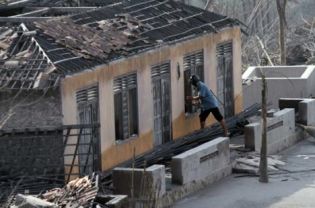 Yogyakarta. Tens of thousands of villagers have already returned to their homes on the slopes of Mount Merapi after authorities reduced the danger zone around the volcano to up to five kilometers following a slowing of its activities.
Yogyakarta. Tens of thousands of villagers have already returned to their homes on the slopes of Mount Merapi after authorities reduced the danger zone around the volcano to up to five kilometers following a slowing of its activities.
Surono, head of the Volcanology and Geological Disaster Mitigation Agency (PVMBG), said on Friday that the danger zone for Sleman, the hardest-hit district in the Merapi eruptions, had been reduced from 20 kilometers from the crater to between 10 and 15 kilometers.
For Magelang and Klaten districts the danger zone is now set at a 10-kilometer radius from the crater, down from 15 kilometers, while in Boyolali it has been put at five kilometers, he said.
The narrowing of the danger zone, he added, followed a drop in the intensity of the eruptions in the past few days.
“However, we have not lowered the status of Mount Merapi from the highest alert and we continue to remind the people of Yogyakarta of the threat of a heavy flow of cold lava via the Code River, which runs though the heart of the city,” he said.
Syamsul Maarif, head of the National Disaster Mitigation Agency (BNPB), said that some 80,000 of the 272,164 evacuees in the four districts surrounding Mount Merapi — Sleman in Yogyakarta, and Magelang, Klaten and Boyolali in Central Java — were believed to have returned to their villages.
Police are still on alert to track the movement of evacuees and warn off curiosity-seekers who, believing the danger over, could hinder relief efforts, he said.
“We have involved the police and soldiers to guard and monitor the evacuees’ movement and bar outsiders who want to go to the disaster area just to have a look,” he said.
Curiosity-seekers wandering into the area, he added, would not only disturb residents trying to get back to their lives, but could also put their own safety at risk if the volcano were to erupt again and they did not know how to evacuate.
Sri Purnomo, the chief of Sleman district, asked returning residents not to take unnecessary risks.
“We have allowed residents to return home, but we are urging them not to try and remain in their homes if they are no longer inhabitable,” he said.
Residents whose homes had been badly damaged, he added, were being asked to salvage what belongings they could and return to the shelters.
At least three shelters in the district, all within 10 kilometers of the crater and which had been abandoned following a major eruption on Nov. 5, will be reopened to accommodate the displaced, he said. Maguwoharjo Stadium in Sleman will continue to function as the main shelter.
Working with the BNPB, the Sleman administration will also build permanent shelters for families.
The shelters will be built within 10 kilometers of the mountain’s peak at a cost of Rp 6 million to Rp 7 million ($670-$785) per unit. Purnomo did not say how many units would be built.
Meanwhile, Social Affairs Minister Salim Segaf Al-Jufri said the government was expected to end the emergency response period for the Mount Merapi eruptions on Wednesday.
“Whether the period will be extended or not will depend on the situation,” he said during a visit to Magelang.
After the end of the emergency response period, the BNPB will begin reconstruction and rehabilitation programs for the Merapi victims, he said.
“Houses that have been damaged or destroyed will be rebuilt and people who have lost cattle will be financially compensated.”
Salim said his ministry had Rp 397 billion in funds to help the disaster victims while more than Rp 3 trillion was also available in stand-by funds to respond to reconstruction and rehabilitation needs.
The minister also said food aid would continue to be distributed to the victims, including those who had returned to their villages, because many of them would have no immediate means to support themselves with their fields and farms damaged.
Mount Merapi began to erupt on Oct. 26.
Its deadly heat clouds descended beyond the original 10-kilometer danger zone during the Nov. 5 eruption, which is believed to have been its largest in more than a century.
The eruptions have killed at least 259 people, and at their peak displaced almost 400,000 people.




